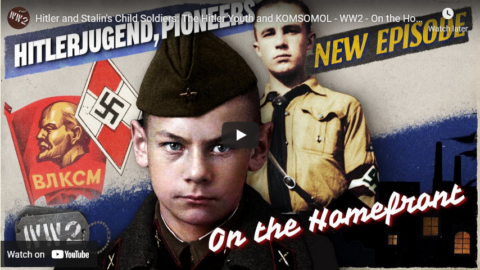World War Two
Published 6 Apr 2021Patriotism and war enthusiasm sweeps through the totalitarian countries in the run-up to the Second World War. This doesn’t leave out children either, who are supposed to become the prime soldiers of the future.
Join us on Patreon: https://www.patreon.com/TimeGhostHistory
Or join The TimeGhost Army directly at: https://timeghost.tvFollow WW2 day by day on Instagram @ww2_day_by_day – https://www.instagram.com/ww2_day_by_day
Between 2 Wars: https://www.youtube.com/playlist?list…
Source list: http://bit.ly/WW2sourcesHosted by: Anna Deinhard
Written by: Fiona Rachel & Spartacus Olsson
Director: Astrid Deinhard
Producers: Astrid Deinhard and Spartacus Olsson
Executive Producers: Astrid Deinhard, Indy Neidell, Spartacus Olsson, Bodo Rittenauer
Creative Producer: Maria Kyhle
Post-Production Director: Wieke Kapteijns
Research by: Fiona Rachel
Edited by: Karolina Dołega
Sound design: Marek KamińskiColorizations by:
– Mikołaj Uchman
– Daniel WeissSources:
– Bundesarchiv
– Library of Congress
– RIAN NOVOSTI: 25358
– Narodowe Archiwum Cyfrowe NAC
– Yad Vashem: 6884/13, 6884/14, 6884/5
– National Archives NARA
– Picture of Boy Scouts at a Campsite courtesy of Springfield College, Archives and Special Collections
– English children at school in 1920s courtesy of pellethepoet from Flickr – https://tinyurl.com/yerg47hn
– Fortepan: 5660, 1371, 32045, 55755,
– Picture of the League of German Girls with children courtesy of Facing History and Ourselves & Hoover Institution Archives – https://tinyurl.com/yzrfozasSoundtracks from Epidemic Sounds:
– “The Inspector 4” – Johannes Bornlöf|
– “Weapon of Choice” – Fabien Tell
– “Remembrance” – Fabien Tell
– “Moving to Disturbia” – Experia
– “Break Free” – Fabien TellArchive by Screenocean/Reuters https://www.screenocean.com.
A TimeGhost chronological documentary produced by OnLion Entertainment GmbH.
From the comments:
World War Two
3 hours ago (edited)
When thinking of people who have been affected by the horrors of war, children are not usually the first group to pop into one’s mind. Of course, fathers away at the front and wartime propaganda bring the war closer to children’s homes, but with state-controlled youth organizations in totalitarian countries, we have yet another topic at our hands, how the war crept into children’s lives. Even though with the end of the war this dark chapter of youth movements in Europe mostly got to an end, clubs and associations are still an important part of youth culture to network and emancipate oneself. Have you been part of a club or other youth organizations in your childhood? Please let us know in the comments.Cheers, Fiona







